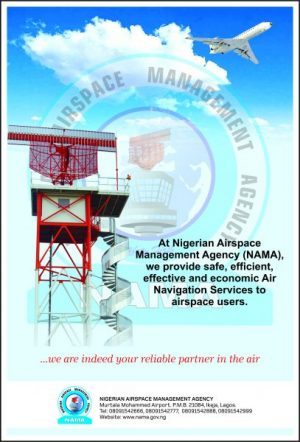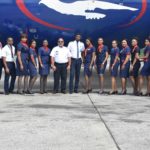 In a bid to facilitate the development and implementation of a National Air Navigation Plan, National Aviation System Block Upgrade (ASBU) Plan, National Air Traffic Management Plan as well as other International Civil Aviation Organization (ICAO) new concepts in Nigeria, the Nigerian Airspace Management Agency (NAMA) has created a National Air Navigation Planning unit, vested with the mandate to oversee the domestication and replication of ICAO global and regional plans for the enhancement of air navigation in the country.
In a bid to facilitate the development and implementation of a National Air Navigation Plan, National Aviation System Block Upgrade (ASBU) Plan, National Air Traffic Management Plan as well as other International Civil Aviation Organization (ICAO) new concepts in Nigeria, the Nigerian Airspace Management Agency (NAMA) has created a National Air Navigation Planning unit, vested with the mandate to oversee the domestication and replication of ICAO global and regional plans for the enhancement of air navigation in the country.
This is just as the agency recently concluded a one-week training for 20 critical personnel to run the newly created unit. The training which held at the headquarters of the agency in Lagos bordered on areas such as Global Air Navigation Plan and its priorities, Global Aviation Safety Plan, Global Aviation Security Plan, National Air Navigation Plan and the National Aviation System Block Upgrade Implementation Plan. Specifically, the training focused on ASBU Block 18 Modules some of which include Airport Collaborative Decision Making; Performance Based Navigation with Vertical Guidance; Continuous Descent Operations and Continuous Climb Operations. Others are Surface Movement Radar and Ground Control; Arrival and Departure Management Systems; Digital Aeronautical Information Management (AIM), System Wide Information Management, Flight Information Collaborative Environment, as well as the strategic objectives of the different modules, their applicability and cost benefit analysis.
Rationalizing the training for the new unit, NAMA Director of Operations, Matthew Lawrence Pwajok who was a facilitator at the training said the job ahead of the team is “both strategic and critical as they would be researching to define future requirements of NAMA and airspace user requirements, in order to enhance airspace capacity, air traffic management capacity, efficiency and economy and safety of flight operations. If we must encourage traffic growth into our airspace, then we must develop strategic growth plans, be sensitive to airline equipage and their user requirements. We need not reinvent the wheel as ICAO has developed adequate strategies for the enhancement of capacity, safety, security, efficiency, etc. We must therefore domesticate these global plans into national plans for implementation in accordance with global, regional or national timelines and priorities,” Pwajok said.
He noted that the team will be required to work towards ensuring the effective implementation of the three major global plans of ICAO which are Global Air Navigation Plan, Global Aviation Safety Plan and Global Aviation Security Plan. According to him, “ICAO is drawing global attention to emerging challenges such as cyber threats or cyber security, therefore we must develop a security plan for our Communication, Navigation and Surveillance/ Air Traffic Management (CNS/ATM) facilities. If these systems are hacked, safety and security could be compromised. Thus, the air navigation planning team will work in collaboration with other agencies as the implementation of some of these ICAO concepts requires collaboration with sister agencies, the users, the military, NCAA, etc.”
“The team will equally interrelate with some ICAO structures such as the Air Navigation Bureau (ANB), Technical Cooperation Bureau (TCB) and Air Transport Bureau (ATB), Regional Aviation Safety Group (RASG) and the AFI Planning and Implementation Regional Group (APIRG), the decision, resolution and conclusions of which impact on our services. We need a team that understands the workings of these ICAO bodies as they are the technical works of ICAO that affect us directly. Finally, the team will be expected to strategize and ensure active participation in ICAO activities, meetings, and workshops, thereby ensuring that NAMA becomes a key player in the affairs of the international body at the regional and global level,” he said.






